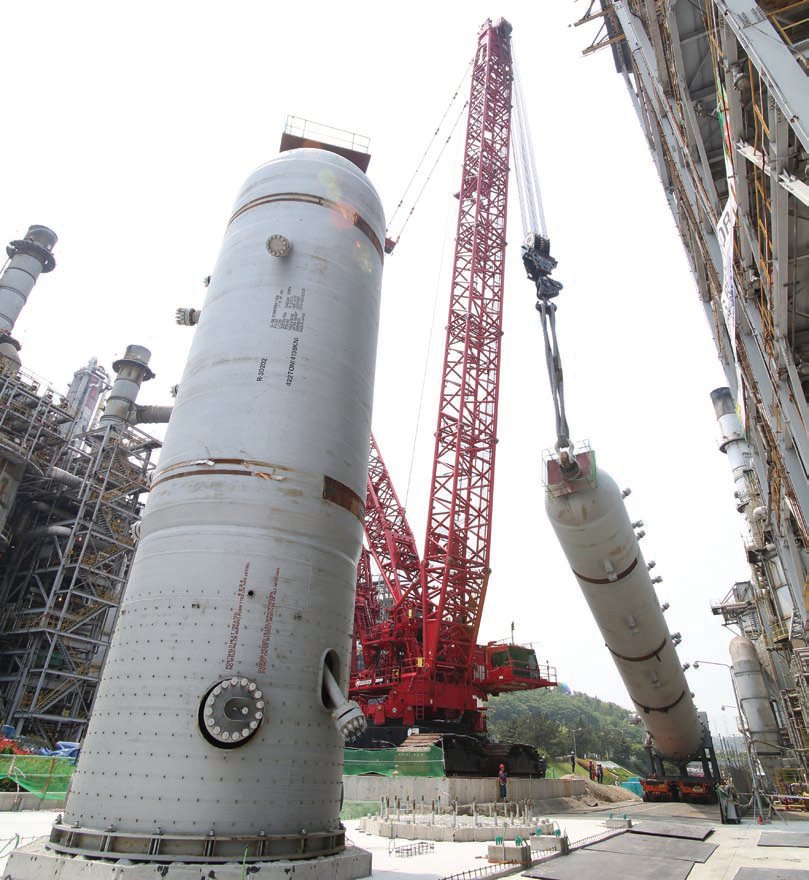High capacity in a tight space
8 September 2015Chunjo put its 2,300t capacity Manitowoc 31000 to work in the tight confines of an S-Oil petrochemical facility in Ulsan, South Korea. While the crane is one of the largest in the world, Chunjo chose it for this job because its VPC or variable position counterweight allows set up in highly restricted environments.
The key feature that gives the 31000 its unmatched capabilities is the patented Variable Position Counterweight, or VPC, which is suspended from the rear of the crane. The VPC operates laterally behind the rotating bed to boost lift capacity.
Having the counterweight suspended from the crane, and not fitted to a mobile tray as alternatives do, means far less ground preparation is required and on-site costs are lower, while allowing the crane to work in smaller spaces.
For the job in Ulsan, South Korea, main contractor Daelim ENC, needed a crane to place two reactors as part of the expansion of the S-Oil petrochemical facility. As the expansion work was taking place within existing infrastructure at the plant, space was extremely limited. To make the lifts, Daelim had to place the crane on a landfilled river, with a road running adjacent to it. However, the road could not accommodate a wheeled or crawler-mounted counterweight tray found on traditional heavy lift cranes, giving the 31000 a distinct advantage.
When planning the space requirements for the crane on site, the closest competitor to the Manitowoc 31000 required an operating area of over 1,200m2, whereas the footprint for the 31000 was just 16m x 21m, or 336m2, a space saving of 70%. Jang Hwan Chang, chairman of Chunjo Construction, said that when assessing the job site it quickly became clear that the Manitowoc 31000 was the best option.
"When we first spoke with Daelim there were several options being considered, but once the true difficulty of the lift work became apparent, the 31000 was a clear favorite and probably the only realistic option," he said. "And these two lifts have been such a success that plant engineers at S-Oil are now looking at future expansion plans and designing larger modules that can take advantage of the 31000's capabilities. This crane will help S-Oil save time and money on future expansion plans, delivering true value to the customer."
For the lift work, the Manitowoc 31000 was equipped with 70m of main boom and 964t of counterweight.
Both picks were made from the same position, first an 800t reactor, which was lifted at 24m radius; and then a 400t reactor that was lifted at 34m radius. Impressive as these lifts are, they fall comfortably within the 31000's lift abilities, as S-Oil had imposed an additional factor of safety on all lifts on the project, limiting them to 75% of the published load chart.
Because of the narrow site, there was no space for a tailing crane.
So Chunjo employed a heavy-duty transporter to tail the reactors as they were moved into position. This had to be done delicately because there were strict limits on the amount of oscillation the reactors could withstand during placement, with particular attention paid to the moment each reactor detached from the tailing transporter.
However, the close control and strength of the 31000 meant that even this potential hazard was negotiated without a problem.
"This job really underlined the true capabilities of the 31000," said Jang Hwan Chang. "It is more economical, requires less preparation and causes less disruption than alternatives."
